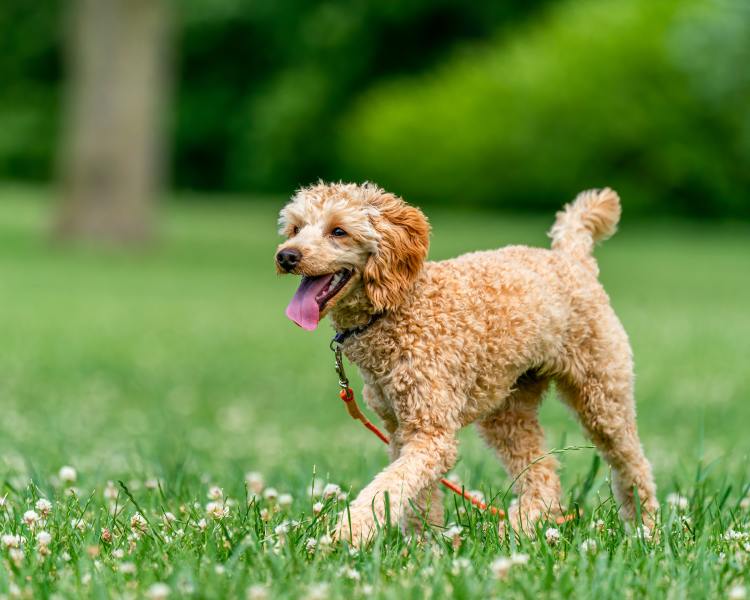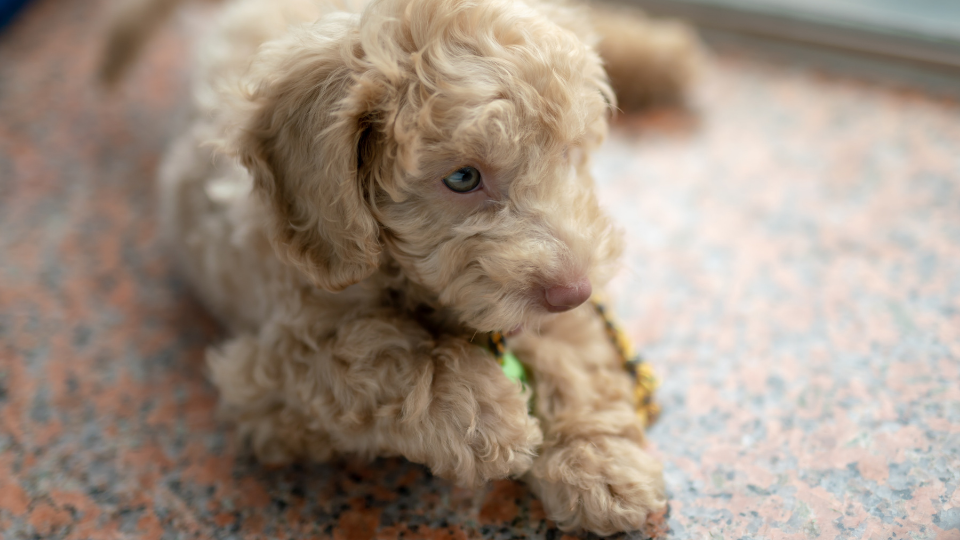Despite their fancy looks, the Poodle is a superb athlete with above-average intelligence that ranks in the American Kennel Club’s top ten most popular dog breeds. Poodles were originally bred in Germany as water retriever dogs. Their famously flamboyant coat had a practical purpose in protecting vital areas from the frigid cold water, keeping them warm and giving them freedom of movement to swim. They are highly versatile dogs that are happy as athletes or companions. If you’re the lucky pet parent of one of these intelligent, proud dogs, you may be asking yourself how large will my Poodle grow and when will they stop growing?
Everything you need to know about Poodle growth:
- Male Poodle Growth & Weight Chart
- Female Poodle Growth & Weight Chart
- Poodle Height Chart
- At what age is a Poodle fully grown?
- How big should a 6-month-old Poodle be?
- How much bigger will my Poodle get?
- What is the size of a full-grown Poodle?
- How do I make sure my Poodle is healthy?
Pro Tip: Want to get reimbursed for up to 90% of your dog’s veterinary bills whenever they are sick or injured? Compare Poodle health insurance options to save yourself future headache.
Poodle Growth & Weight Chart
All puppies are unique, so please keep in mind that the following numbers are all estimates. There is a sizable difference in weight between male and female Poodles, but they tend to be around the same height. If you notice your Poodle puppy is significantly behind or ahead of the following numbers, consult with your veterinarian about their individual growth rate. Otherwise, don’t worry if they’re slightly off from the weight and height ranges below!
Male Poodle Growth and Weight Chart
| Age | Weight |
|---|---|
| 1 month | 5 - 9 lbs |
| 2 months | 16 - 20 lbs |
| 3 months | 22 - 26 lbs |
| 4 months | 30 - 35 lbs |
| 5 months | 35 - 41 lbs |
| 6 months | 41 - 48 lbs |
| 7 months | 48 - 55 lbs |
| 8 months | 50 - 57 lbs |
| 9 months | 52 - 61 lbs |
| 10 months | 55 - 63 lbs |
| 11 months | 57 - 68 lbs |
| 1 year | 60 - 70 lbs |
| 2 years | 60 - 70 lbs |
Female Poodle Growth and Weight Chart
| Age | Weight |
|---|---|
| 1 month | 4 - 7 lbs |
| 2 months | 11 - 16 lbs |
| 3 months | 20 - 24 lbs |
| 4 months | 24 - 28 lbs |
| 5 months | 26 - 30 lbs |
| 6 months | 28 - 34 lbs |
| 7 months | 30 - 36 lbs |
| 8 months | 32 - 38 lbs |
| 9 months | 34 - 40 lbs |
| 10 months | 36 - 44 lbs |
| 11 months | 38 - 46 lbs |
| 1 year | 40 - 50 lbs |
| 2 years | 40 - 50 lbs |
Poodle Height Chart
| Age | Height |
|---|---|
| 2 months | 12 - 13 inches |
| 3 months | 14 - 15 inches |
| 4 months | 18 - 19 inches |
| 6 months | 18 - 22 inches |
| 24 months | 18 - 24 inches |
*The above height numbers are measured from the floor to a standing Poodle’s highest point at their shoulders.
At what age is a Poodle fully grown?
Poodles are considered fully grown adults at two years old and tend to show emotional signs of maturity, like a calmer nature, around 18 months.
At a year old, most Poodles will have reached their final height or very close to it. However, most Poodles will require a full two years to fill out their chest and reach their final weight.
 (Image Source: Pexels)
(Image Source: Pexels)
How big should a 6-month-old Poodle be?
A six-month-old male Poodle will weigh around 41 to 48 pounds, while a six-month-old female Poodle will weigh about 28 to 34 pounds. Both male and female Poodles at this age stand at around 18 to 22 inches tall, which for some Poodles is already their full adult height.
Pro Tip: Check out this ultimate pet parent guide with 39 dog care tips on pet first aid kits, puppy-proofing practices, training, veterinary appointments, and more!
How much bigger will my Poodle get?
There are a few ways to assess how much bigger your Poodle will get. The first is age. If your Poodle is less than a year old, they still have significant growth left! If your Poodle is between one and two years old, they are likely still filling out a bit, but are probably at their adult height.
Next, you can take a look at your Poodle’s paws. Do they still look oversized next to their legs and body? If this is the case, they are probably still filling out as this is a classic puppy feature!
Lastly, you can reach out to your Poodle’s breeder. Your breeder can provide you with a more precise estimate of your Poodle puppy’s final weight and height based on your puppy’s parents and past litters. A Poodle puppy will rarely grow larger than their bigger parent, so this will also give you an idea of their maximum size.
What is the size of a full-grown Poodle?
According to the American Kennel Club Official Poodle Standards, an adult male Poodle is 60 to 70 pounds while an adult female Poodle weighs between 40 and 50 pounds. By these standards, full-grown Poodles will be over 15 inches tall when measuring from the ground to the highest point of their shoulders while standing. Most Standard Poodles will stand between 18 and 24 inches tall.
 (Image Source: Unsplash)
(Image Source: Unsplash)
How do I make sure my Poodle is healthy?
Smart lifestyle choices are essential in keeping your Poodle happy and healthy. For starters, it’s vital that your Poodle gets enough exercise daily. The Veterinary Centers of America recommend a long walk, jog, or intense play to fulfill their daily exercise needs. Poodles were bred as retrievers and, as such, are keen on games involving retrieving (like fetch). Many Poodles also enjoy swimming. However, a full coat can weigh them down, so keep this in mind depending on how your Poodle’s coat is cut.
Due to their full coats, Poodles can put on excess weight without their pet parents realizing it. It’s vital that you regularly use your hands to feel your Poodle’s body to check for weight problems. Poodles are not overly prone to weight issues with a balanced diet, but their coat can disguise weight changes.
Their full coats also require regular upkeep like brushing and combing every other day, professional grooming every six weeks or so, and watching for potential eye problems. Poodles are prone to weeping eyes and eye irritation from lashes or hair, so keeping their eye area free of long hair is ideal.
As a purebred dog breed, Poodles are more susceptible to genetic health problems. In particular, Poodles are prone to bloat, Addison’s Disease, Epilepsy, Hip Dysplasia, Hypothyroidism, and eye diseases, according to the Poodle Club of America. Many of these genetic health problems can be screened for early on using DNA technology. These early screenings can help you and your veterinarian prevent and minimize health complications from these genetic diseases. A
bove all else, regular veterinary care is the best way to make sure your Poodle stays healthy. Between health screenings, regular veterinary care, bloodwork, x-rays, dental cleanings, and more, your veterinarian is your best resource in caring for your precious Poodle puppy.
Be aware, vet visits can quickly become expensive - especially when immediate treatment or surgery is needed for an emergency or illness. When surveyed, 4 out of 5 pet parents say they would be unable to cover a $5,000 veterinary bill out of pocket. With many treatments and surgeries costing thousands of dollars, this can quickly put pet parents in a pinch should the worst happen to their pet. Poodles are larger dogs, which can also increase the price of treatment. This is where pet insurance comes in.
Pet insurance reimburses you for out-of-pocket veterinary costs and provides a safety net should the worst happen to your Poodle. As purebred dogs, Poodles are more prone to genetic health problems, like bloat or hip dysplasia, which can quickly become expensive to treat. Dog health insurance allows you to provide your Poodle with top-notch veterinary care so that you can focus on what’s really important - your pup’s wellbeing and happiness.
Final Considerations
Poodle puppies grow into elegant, proud dogs who are true aristocrats of the dog kingdom. We know how much your Poodle pup means to you and that they deserve the best! Give yourself peace of mind today when you use Pawlicy Advisor to compare personalized pet insurance quotes from the top Poodle pet insurance companies.
Pawlicy Advisor’s personalized recommendations can help you save up to 83% on dog health insurance costs over your dog’s lifespan.
